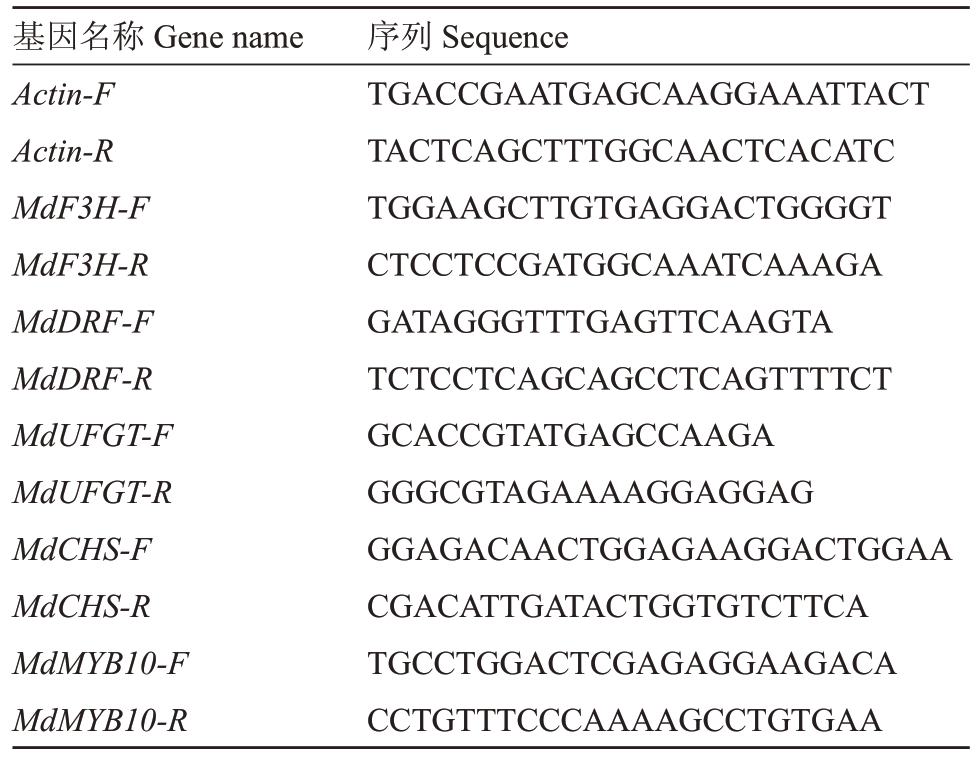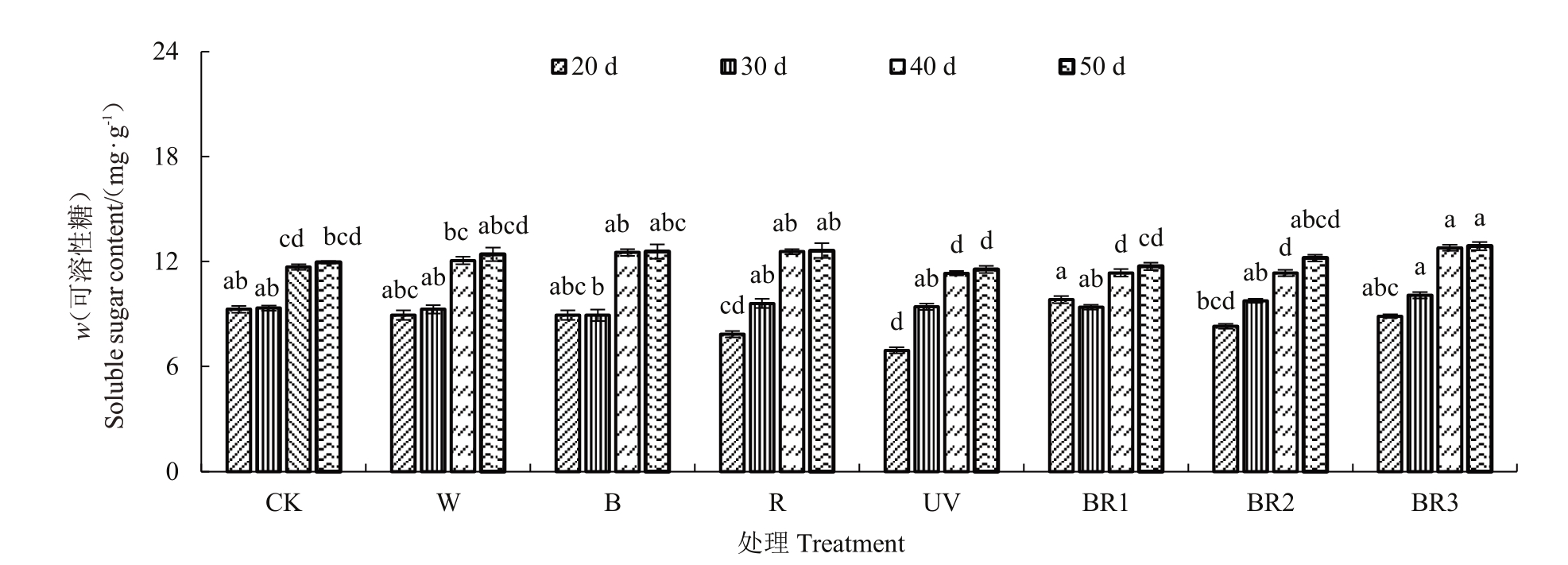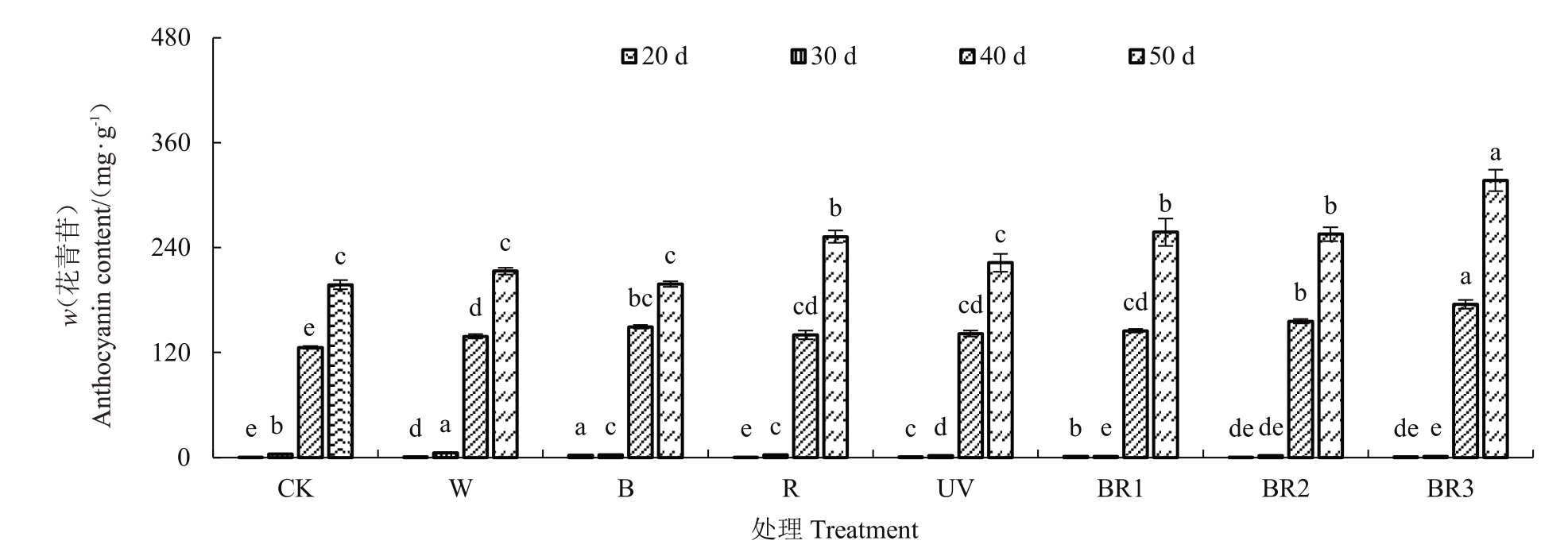我国苹果栽培面积和产量均居世界首位[1]。富士是我国苹果的主栽品种,占我国苹果栽培面积的70%[2]。由于产地与气候条件的不同,果实品质存在差异[3]。光环境中光质变化对不同植物的果实品质影响显著[4]。
不同光质补光主要改善了树体的光照条件,进而影响果实各项指标,包括可溶性糖含量、可滴定酸含量、可溶性固形物含量、维生素C含量、果实硬度、果实色泽、花青苷含量、单果质量、果形指数等[5-8]。研究表明,在设施栽培樱桃中补光提高樱桃糖分含量,促进了果实成熟进度,比对照组提早6 d 左右[9]。在草莓研究中发现,补光有利于提高设施草莓产量、改善果实外观和内在品质[10]。补光有利于改善瑞都香玉葡萄果实品质,促进葡萄果实发育、成熟[11]。补光可以促进马铃薯营养生长及生物量积累,进而提高马铃薯产量、改善块茎品质[12]。在金鹏1 号番茄上的研究发现,补充LED 光质能够增加果实中可溶性固形物含量,提高果实含酸量[13]。崔晓辉等[14]在薄皮甜瓜中研究发现,补光有利于增加果实中可溶性糖含量。在西葫芦研究中发现,补光处理显著提高果实中维生素C含量和糖酸比[15]。
花青苷合成是通过苯丙氨酸途径来实现的,其相关基因主要有二氢黄酮醇还原酶(dihydroflavonol 4-reductase,DFR)、类黄酮糖苷转移酶(UDP glycose: flavonoid 3-O-glucosyl transferase,UFGT)、查尔酮合成酶(chalcone synthase,CHS)、黄烷酮3-羟化酶(flavanone-3-hydroxylase,F3H)和MdMYB10。
光是苹果生产过程中的重要环境因素之一,影响苹果果实品质形成。但目前对于光质调控苹果果实品质形成的机制尚未见报道。因此笔者以烟富3/M9-T337苹果为试材,进行不同光质调控,比较果实色泽及内在品质差异,探究光质对果实品质的影响,从而筛选出提高苹果品质的适宜光质配比,为提高苹果果实品质提供参考。
1 材料和方法
1.1 试验材料
试验于2022年5月开始在辽宁省兴城市中国农业科学院果树研究所温泉试验基地苹果栽培示范园进行,试验材料为七年生的烟富3,嫁接砧木为M9-T337矮化砧。
1.2 试验处理
选取生长良好、长势一致的植株96 株,分成8组,自然不补光为对照(CK)、白光(W)、蓝光(B)、红光(R)、紫外光(UVA),以及补光强度组合(蓝光∶红光)BR1(1∶9)、BR2(1∶6)、BR3(1∶3),每组12 株重复,每株树采2 个果实用于测定。不同处理组间留有1株保护树,排除处理间的相互干扰。于9月1日至11月6日进行补光,补光时间为05:00—07:00与18:00—21:00,补光时间总计66 d 共330 h,通过定时器来控制不同处理补光时间。果实于幼果期进行套袋处理,于10月12日进行摘袋。果实采收时间为9 月30 日、10 月12 日、10 月24 日、11 月6 日,当日07:30 开始采收,一半用液氮保存后进行后续指标测定,另一半及时进行果实品质相关指标的测定。光源为上海合鸣公司生产50 W圆盘形植物补光灯,补光灯在植株正上方,高度一致,距离地面2.5 m。各处理组其他田间管理一致。土壤pH 值为6.9,有机质含量(w,后同)为14.70 g·kg-1,碱解氮含量为88.03 mg·kg-1,速效磷含量为64.64 mg·kg-1,速效钾含量为128.10 mg·kg-1。
1.3 果实品质指标测定
用水浴恒温紫外可见分光光度计测定可溶性糖含量;用905全自动电位滴定仪测定可滴定酸含量;用PAL-1 型折射仪测定可溶性固形物含量;用905全自动电位滴定仪测定维生素C 含量;用TA-HDplus物性分析仪测定果实硬度。
采用紫外可见分光光度计法测定花青苷含量[16],称取粉碎后的样品0.2 g 于10 mL 压口离心管中,放入5 mL 提取液,盖盖并摇匀,避光保存24 h,取出放入离心机中50 ℃、6000 r·min-1离心5 min。提取上清液放入10 mL 压口离心管中,用水浴恒温紫外可见分光光度计进行测定。
采用CM-700d型色差仪测定果实色泽参数(L、a、b、c、h),每次测定前用D65 光源,0 ℃观察角,白色标准色板进行校准;值越大表示样品表面光泽越好;a值正值为红色,值越大表示红色越深;b值正值为黄色,值越大表示黄色越深;h值其变化范围在0~180°,h<50°时,值越小红色越深;c 值为色饱和度,其值越大表示颜色越纯。
采用RNAprep Pure Plant Plus Kit试剂盒(DP441,天根,中国)提取样品总RNA,以RNA为模板,使用反转录试剂盒TransScript®One-Step gDNA removal and cDNA Synthesis SuperMix合成cDNA。
采用试剂盒PerfectStart Green qPCR SuperMix(Vazyme,中国)和荧光定量PCR仪(Bio-Rad,美国)进行实时荧光定量PCR(qRT-PCR)。引物由生工生物工程有限公司合成。引物序列见表1。以MdActin为内参基因,按2-ΔΔCT法计算基因相对表达水平。
表1 引物序列
Table 1 Primer sequence

?
1.4 数据处理与分析
使用Excel 2019 软件进行试验数据整理,采用SAS 9.4 进行数据处理分析,检验范围p<0.05 为显著,p<0.01 为极显著。所有试验均3 次重复,结果用“平均值±标准误”来表示。
2 结果与分析
2.1 不同光质补光对果实内在品质的影响
2.1.1 不同光质补光对果实糖酸含量的影响 由图1 显示,不同光质补光影响苹果果实中可溶性糖含量的积累。30 d 时R、UV、BR2、BR3 处理可溶性糖含量迅速增加,40 d 时所有处理可溶性糖含量均同步大幅度上升,50 d 时BR3 处理可溶性糖含量高于其他处理,与CK 相比增加了7.69%,这表明BR3 处理对促进可溶性糖含量的积累效果最为显著。此外,单红光、蓝光和白光也对果实的可溶性糖含量有较大影响,分别比对照增加了5.51%、5.10%、3.76%。由图2可知,与其他处理不同,白光与紫外光处理30 d内可滴定酸含量无明显下降趋势。紫外光与BR2、BR3 处理在40 d 时可滴定酸含量略有上升。所有处理均在第50 天时可滴定酸含量出现显著下降,其中蓝光处理可滴定酸含量下降最为显著,下降15.60%。BR1、BR3和白光的影响次之,分别降低了7.91%、8.11%、9.33%。BR2处理与对照相比仅降低了1.81%。红光处理与对照相比可滴定酸含量升高1.85%。

图1 不同处理各时期可溶性糖含量
Fig.1 Soluble sugar content in different periods of different treatments
CK.对照自然不补光;W.白光;B.蓝光;R.红光;UVA.紫外光;BR1.蓝光∶红光=1∶9;BR2.蓝光∶红光=1∶6;BR3.蓝光∶红光=1∶3。不同小写字母表示不同处理在同一时期差异显著(p<0.05)。下同。
CK.Control natural light;W.White light;B.Blue light;R.Red light;UVA.Ultraviolet light;BR1.Blue light∶red light=1∶9;BR2.Blue light∶red light=1∶6;BR3.Blue light∶red light=1∶3.Different small letters repesent significant differerence among different tratments at the same period(p<0.05).The same below.

图2 不同处理各时期可滴定酸含量
Fig.2 Titratable acid content of different treatments in each period
2.1.2 不同光质补光对果实可溶性固形物含量的影响 由图3 所示,30 d 时所有处理的可溶性固形物含量与20 d时相比均呈上升趋势,40 d时除蓝光、紫外光处理以及对照外,其他处理均有所上升。50 d时红光与BR3 处理果实中的可溶性固形物含量最高,达到了对照的1.18 倍。BR2 处理果实中的可溶性固形物含量达到了对照的1.13 倍。而BR1、紫外光、白光和蓝光处理与对照相比,果实中可溶性固形物含量分别提高4.50%、5.05%、3.86%、6.86%。试验结果表明,不同光质补光均能提高果实中可溶性固形物含量,其中红光和BR3处理对增加果实中可溶性固形物含量的作用最为显著。

图3 不同处理各时期可溶性固形物含量
Fig.3 Soluble solids content of different treatments in each period
2.1.3 不同光质补光对果实维生素C 含量的影响由图4 可知,20 d 时对照与红光以及BR2 处理维生素C 含量达到峰值。30 d 时白光、蓝光、紫外光、BR1以及BR3处理维生素C含量达到峰值。40 d时各处理维生素C含量均有所下降。50 d时红光处理果实中维生素C 含量最高,与对照相比增加了28.35%,其次为紫外光处理,增加了18.53%。BR1、BR2和BR3三个处理与对照相比,分别显著增加了10.60%、4.24%、10.49%。白光处理对维生素C 含量影响最小,仅增加了1.11%,蓝光处理使维生素C含量显著减少6.44%。

图4 不同处理各时期维生素C 含量
Fig.4 Vitamin C content in different periods of different treatments
2.1.4 不同光质补光对果实硬度的影响 补光20 d 时果实硬度最高,不同补光处理的果实硬度均高于对照。随着果实成熟度逐渐增加,果实硬度逐渐降低。在50 d 时,BR1、BR2、BR3 三个处理均显著增加了果实的硬度,与对照相比分别提高14.83%、15.60%、16.37%。红光和蓝光与对照相比分别显著提高了11.76%、8.95%(图5)。

图5 不同处理各时期果实硬度
Fig.5 Fruit firmness of different treatments in different periods
2.2 不同光质补光对果实外在品质的影响
2.2.1 不同光质补光对果实着色的影响 由表2 可知,在40 d 时,L、b、h 降低,a 值与c 值增大。在50 d时,一定程度上补光降低了L、b、h值,增大了a值和c 值,与对照相比不同光质补光均降低了L 值,其中BR1 处理最为显著,降低了14.97%。白光、红光和紫外光处理的a 值分别比对照显著增大16.02%、17.05%、17.65%,而蓝光处理仅增大10.19%。另外,红蓝组合光处理相较于对照a 值分别增大18.31%、11.42%、16.45%。此外,BR1处理对c值的增大效果最为显著。与对照相比各处理均降低了h值。综上所述,不同光质补光均能促进果实着色,但促进的效果不同,BR3处理促进果实着色效果最为显著。
表2 不同光质对果实着色的影响
Table 2 Effects of different light qualities on fruit coloring

注:同列数据后不同小写字母表示同一品种处理间差异显著(p<0.05)。
Note:After the same column of data,different lowercase letters indicate that there is a significant difference between the treatments of the same variety(p<0.05).
?
2.2.2 不同光质补光对果实花青苷含量的影响 由图6 可知,20 d 为果实未摘袋条件下的果皮花青苷含量,其含量较低。30 d 为果实刚摘袋条件下果皮中花青苷含量,无明显变化。40 d 时各处理的果皮花青苷含量迅速上升,上升幅度最为显著。50 d 时BR3 处理的果皮花青苷含量最高,是对照的1.6 倍。BR1 和BR2 在一定程度上提升果皮中花青苷含量,是对照的1.29 倍,但显著低于BR3 处理。补充单红光也能促进果皮中花青苷的积累,但相对于对照,仅有1.13倍的增加效果。而补充白光和蓝光对果皮花青苷含量的增加并没有显著作用。

图6 不同处理各时期花青苷含量
Fig.6 Anthocyanin content in different periods of different treatments
荧光定量PCR分析了苹果果皮中5个花青苷合成相关基因的表达水平(图7)。在50 d 时,BR1 与BR3处理MdDFR基因表达量显著上调。在20 d时,UV 处理MdMYB10 基因表达量显著上调。在20 d与50 d 时,BR3 处理MdF3H 基因表达量上调显著,50 d时W与BR1处理基因表达量增加。在40 d时,各补光处理MdCHS基因表达量均上调。在20 d时,BR3 处理MdUFGT 基因表达量上调最为显著。在50 d 时,BR3 处理MdDFR 和MdF3H 基因表达量显著上调,分别是对照的4.17 倍、6.71 倍,MdMYB10、MdCHS、MdUFGT 基因表达量均有所上调,是对照的5.03倍、5.23倍、1.94倍。

图7 不同处理各时期花青苷合成基因表达水平
Fig.7 The expression levels of anthocyanin synthesis genes in different treatments at different stages
3 讨 论
3.1 不同光质对果实外在品质的影响
果实色泽、果形指数、单果质量、果实硬度等都是果实外在品质的重要指标。果实的红或紫色是花青素的颜色,通常以花青苷的形式存在[17]。苹果果皮中的红色色素主要是花青苷,花青苷含量越高果皮着色越佳。查倩等[18]研究发现,转色期对巨峰葡萄补光显著增加了果实中花色苷的含量,明显改善红色系葡萄着色,提高果实品质。在设施草莓研究中发现,补光能够改善草莓果实的外观品质,且红蓝(3∶1)组合光处理下效果显著[19]。在黄瓜研究中也有相同的发现,红蓝组合光能够改善黄瓜果实的外观品质,红蓝组合光(3∶1)显著高于其他组合[20]。本研究结果表明,红蓝(3∶1)光处理下,果实着色效果最佳,果皮花青苷含量增加效果最为显著,是对照的1.6 倍。红蓝(9∶1)、红蓝(6∶1)、红蓝(3∶1)、红光、蓝光5种补光处理下苹果果实硬度显著高于对照,且分别较对照高14.83%、15.60%、16.37%、11.76%、8.95%。由此表明,在苹果栽培中,采用红蓝组合光进行补光可以显著改善苹果果实的外观品质。
3.2 不同光质对果实内在品质的影响
可溶性糖、可滴定酸、可溶性固形物、维生素C等物质的含量是决定果实内在品质的重要指标,不同光质补光对果实内在品质影响较大,从而可通过调节光质来改善果实内在品质。在草莓研究中发现,增加红光可提高草莓果实中的可溶性糖与维生素C含量[21-22]。在番茄研究中也得到了相同的结论,红色光质显著提高了番茄果实维生素C 含量[23-24]。时晓芳等[25]采用不同光质对阳光玫瑰葡萄补光发现,果实发育后期补充红光有利于果实中可溶性固形物的积累。设施红地球葡萄研究中发现,不同光质补光均能增加果实中可溶性糖、可溶性固形物以及花青苷的含量[26]。在南高丛越橘上研究发现,红蓝光(3∶1)能够显著提高果实可溶性糖、花青苷、可溶性固形物含量[27]。以上试验结果与本实验结论一致。在本研究中,红光处理与对照相比果实维生素C含量增加了28.35%,在红蓝组合光(3∶1)处理下苹果果实可溶性糖和可溶性固形物含量最高,同时也较为显著地降低了果实中可滴定酸含量。以上研究结果表明,不同光质补光能改善苹果果实品质,但光质如何影响植物基因表达、物质合成和转运等过程,从而调控苹果果实品质的机制尚不清楚。
用单一光源进行补光时,红光的作用非常明显。Osman等[28]研究发现红光有利于萝卜芽苗菜生长,提高产量,增加维生素C含量。红光有利于提高叶片中叶绿素含量,蓝光则降低了叶片中叶绿素的含量。研究发现增强红色波段光,果实品质较对照有明显提高,用不同光质处理番茄,发现红光可以显著提高果实可溶性糖和有机酸含量[29]。本研究结果表明,红光可以显著提高苹果果实中可溶性糖和可滴定酸的含量,并且还能增加维生素C 的含量。相比之下,蓝光和紫外光对果实品质的作用相对较弱。本研究结果表明,蓝光和紫外光可以降低苹果果实中可滴定酸的含量,紫外光能有效促进果实的着色,增加果皮中花青苷的含量。
红光与蓝光对植物生长发育的作用存在差异,红蓝组合光则可以弥补两者不足,结合红光及蓝光的个体补光优势,更有利于植物的形态建成以及生长发育。红蓝混合LED 补光能显著提高葡萄[11]、番茄[13]、甜瓜[14]的可溶性固形物、果糖、葡萄糖和蔗糖含量。适合比例的红蓝组合光能提高草莓果实的糖含量[10]。陈祥伟等[30]的补光研究结果表明,红蓝组合光处理下小白菜生长发育、光合特性及品质指标均显著高于其他处理。在温室甜椒上研究发现,红蓝组合光能够增加果实中可溶性糖的含量[31]。在生菜研究中发现,红蓝组合光能够增加生菜中抗坏血酸的含量[32]。
果皮的发红是由花青素的种类和含量决定的。花青素生物合成基因的表达由MBW 复合物决定,该复合物由MYB、bHLH 和WD40 三种转录因子组成。MYB蛋白可直接与编码查尔酮合酶(CHS)、查尔酮异构酶(CHI)、黄烷酮-3-羟化酶(F3H)、类黄酮3’-羟化酶(F3′H)和黄酮醇合酶(FLS)的花青素生物合成基因启动子结合。苹果花青素生物合成中的关键MYB调节因子是MdMYB10[33]。MdMYB10通过激活编码二氢黄酮醇4-还原酶(DFR)和类黄酮3-葡萄糖基转移酶(UFGT)等花青素合成基因来促进花青素的积累[34]。当花青素生物合成基因表达量上调时,花青苷的含量随之上升。
4 结 论
当红光和蓝光的比例为3∶1 时,对苹果品质的提升效果最佳。红蓝3∶1组合光不仅可以显著提高苹果果实的糖含量和可溶性固形物含量,同时还能明显降低可滴定酸的含量,促进苹果果皮中花青苷的合成,加速着色,提高果实品质。综上所述,红蓝3∶1 组合光对苹果品质的提升起到最为显著的作用。
[1] 陈学森,韩明玉,苏桂林,刘凤之,过国南,姜远茂,毛志泉,彭福田,束怀瑞.当今世界苹果产业发展趋势及我国苹果产业优质高效发展意见[J].果树学报,2010,27(4):598-604.CHEN Xuesen,HAN Mingyu,SU Guilin,LIU Fengzhi,GUO Guonan,JIANG Yuanmao,MAO Zhiquan,PENG Futian,SHU Huairui. Discussion on today’s world apple industry trends and the suggestions on sustainable and efficient development of apple industry in China[J]. Journal of Fruit Science,2010,27(4):598-604.
[2] 匡立学,徐国锋,陈志军,李银萍,程杨,沈友明.2017 年中国‘富士’苹果品质数据集[J].农业大数据学报,2022,4(3):49-53.KUANG Lixue,XU Guofeng,CHEN Zhijun,LI Yinping,CHENG Yang,SHEN Youming. Quality datasets of‘Fuji’apples cultivated in China in 2017[J]. Journal of Agricultural Big Data,2022,4(3):49-53.
[3] 李卓,郭玉蓉,孙立军,刘婧琳,李景景,付成程.不同产地长富2 号苹果品质差异及其与地理坐标的相关性[J].陕西师范大学学报(自然科学版),2012,40(4):98-103.LI Zhuo,GUO Yurong,SUN Lijun,LIU Jinglin,LI Jingjing,FU Chengcheng. Quality differences of Nagafu 2 apple from different habitats and its correlation with geographical coordinates[J].Journal of Shaanxi Normal University (Natural Science Edition),2012,40(4):98-103.
[4] 李元景,曹兵,万仲武,张悦,马冲.不同光质对灵武长枣生长与光合特性的影响[J].经济林研究,2022,40(3):77-86.LI Yuanjing,CAO Bing,WAN Zhongwu,ZHANG Yue,MA Chong. Effect of light quality on growth and photosynthetic characteristics of‘Lingwuchangzao’[J]. Non-wood Forest Research,2022,40(3):77-86.
[5] YANG W H,ZHU X C,BU J H,HU G B,WANG H C,HUANG X M. Effects of bagging on fruit development and quality in cross-winter off-season Longan[J]. Scientia Horticulturae,2009,120(2):194-200.
[6] ASREY R,KUMAR K,SHARMA R R,MEENA N K. Fruit bagging and bag color affects physico-chemical,nutraceutical quality and consumer acceptability of pomegranate(Punica granatum L.) arils[J]. Journal of Food Science and Technology,2020,57(4):1469-1476.
[7] 王子盾,王辉,冯郁晨,张学良,闫雷玉,刘小杰,赵政阳.不同颜色育果袋对‘瑞雪’苹果果实品质的影响[J].中国农业科学,2023,56(4):729-740.WANG Zidun,WANG Hui,FENG Yuchen,ZHANG Xueliang,YAN Leiyu,LIU Xiaojie,ZHAO Zhengyang. Effects of different color fruit bags on fruit quality of‘Ruixue’apple[J]. China Agricultural Sciences,2023,56(4):729-740.
[8] WANG S Y,FANG H,XIE J M,WU Y,TANG Z Q,LIU Z C,LV J,YU J H.Physiological responses of cucumber seedlings to different supplemental light duration of red and blue LED[J].Frontiers in Plant Science,2021,12:709313.
[9] 李都岳,吴延军.补光对设施栽培樱桃果实成熟和糖分积累的影响[J].果树学报,2023,40(10):2183-2194..LI Duyue,WU Yanjun. Effects of supplementary light on ripening and sugar accumulation of cherry under protected cultivation[J].Journal of Fruit Science,2023,40(10):2183-2194.
[10] 杨肖芳,张豫超,苗立祥,孙晨栋,蒋桂华.LED 补光对不同设施栽培草莓品种营养生长与果实品质的影响[J].浙江农业科学,2023,64(4):864-869.YANG Xiaofang,ZHANG Yuchao,MIAO Lixiang,SUN Chendong,JIANG Guihua. Effects of LED supplementary light on the nutritional growth and fruit quality of strawberry varieties cultivated in different facilities[J]. Journal of Zhejiang Agricultural Sciences,2023,64(4):864-869.
[11] 张克坤,刘凤之,王孝娣,史祥宾,王宝亮,郑晓翠,冀晓昊,王海波.不同光质补光对促早栽培‘瑞都香玉’葡萄果实品质的影响[J].应用生态学报,2017,28(1):115-126.ZHANG Kekun,LIU Fengzhi,WANG Xiaodi,SHI Xiangbin,WANG Baoliang,ZHENG Xiaocui,JI Xiaohao,WANG Haibo.Effects of supplementary light with different wavelengths on fruit quality of‘Ruidu Xiangyu’grape under promoted cultivation[J]. Chinese Journal of Applied Ecology,2017,28(1):115-126.
[12] 彭佃亮,迟文娟,信国琛,唐玉海,张敬敏.不同时段补光对日光温室早春茬马铃薯光合特性、产量和品质的影响[J].中国瓜菜,2022,35(1):65-69.PENG Dianliang,CHI Wenjuan,XIN Guochen,TANG Yuhai,ZHANG Jingmin. Effect of supplemental illumination in different periods on photosynthetic characteristics,yield and quality of potato in solar greenhouse[J]. China Cucurbits and Vegetables,2022,35(1):65-69.
[13] 于经纬,罗博特,岳钉伊.不同CO2 浓度与LED 补光组合对番茄果实品质的影响[J].农村经济与科技,2017,28(8):41-42.YU Jingwei,LUO Bote,YUE Dingyi. Effects of different CO2 concentrations and LED supplemental light combinations on tomato fruit quality[J]. Rural Economy and Science-Technology,2017,28(8):41-42.
[14] 崔晓辉,郭小鸥,孙天宇,齐红岩.LED 补光对薄皮甜瓜幼苗生长及果实品质的影响[J].植物生理学报,2017,53(4):657-667.CUI Xiaohui,GUO Xiaoou,SUN Tianyu,QI Hongyan. Effects of LED supplementary lighting on seedling growth and fruit quality of oriental melon[J]. Plant Physiology Journal,2017,53(4):657-667.
[15] 王舒亚,徐威,唐中祺,王鹏,景涛,刘琪,马正宇,吕剑,郁继华.不同补光时长对日光温室西葫芦生长、品质及产量的影响[J].中国瓜菜,2020,33(4):23-27.WANG Shuya,XU Wei,TANG Zhongqi,WANG Peng,JING Tao,LIU Qi,MA Zhengyu,LÜ Jian,YU Jihua.Effects of different duration of light supplementation on growth,quality and yield of Cucurbita pepo in greenhouse[J]. China Cucurbits and Vegetables,2020,33(4):23-27.
[16] 张华磊,毛柯,刘志,谢兴斌,冯晓明,郝玉金.MdMYB1 转录因子调控红星苹果果实着色的计算机模拟分析及表达验证[J].园艺学报,2009,36(11):1581-1588.ZHANG Hualei,MAO Ke,LIU Zhi,XIE Xingbin,FENG Xiaoming,HAO Yujin. In silico analysis and expression confirmation of the regulation of fruit coloration by transcriptional factor MdMBY1 in delicious apple[J]. Acta Horticulturae Sinica,2009,36(11):1581-1588.
[17] 高原,孙百灵,曲柏宏.果树果实着色研究进展[J].湖南农业科学,2011(22):25-26.GAO Yuan,SUN Bailing,QU Baihong. Research progress on fruit coloring of fruit trees[J].Hunan Agricultural Sciences,2011(22):25-26.
[18] 查倩,奚晓军,殷向静,蒋爱丽.转色期补光处理对鲜食葡萄‘巨峰’和‘巨玫瑰’果实品质的影响[J].中国农学通报,2022,38(31):55-59.ZHA Qian,XI Xiaojun,YIN Xiangjing,JIANG Aili. Effects of supplementary lighting in veraison period on fruit quality of table grape‘Kyoho’and‘Jumeigui’[J].Chinese Agricultural Science Bulletin,2022,38(31):55-59.
[19] 阳圣莹,白胜,蒋浩宏,朱亮,周霓,李曦怡,朱润华.不同补光处理对设施草莓光合特性及果实品质的影响[J].山西农业科学,2016,44(9):1298-1303.YANG Shengying,BAI Sheng,JIANG Haohong,ZHU Liang,ZHOU Ni,LI Xiyi,ZHU Runhua. Effects of different supplemental lighting treatments on photosynthetic characteristics and fruit quality of strawberry in greenhouse[J]. Journal of Shanxi Agricultural Sciences,2016,44(9):1298-1303.
[20] 刘晓英,徐文栋,焦学磊,徐志刚.不同配比红蓝LED 光对黄瓜果实产量和品质的影响[J].植物资源与环境学报,2016,25(2):80-84.LIU Xiaoying,XU Wendong,JIAO Xuelei,XU Zhigang. Effect of different proportions of red and blue LED lights on yield and quality of fruit of Cucumis sativus[J].Journal of Plant Resources and Environment,2016,25(2):80-84.
[21] 吴鹏飞,王丽娟,刘昭,切岩祥和.LED 补光对设施草莓生长及果实品质的影响[J].北方园艺,2016(21):48-50.WU Pengfei,WANG Lijuan,LIU Zhao,KIRRIIWAYoshikazu.Effect of LED supplemental lighting treatment on protected strawberry growth and fruit quality[J]. Northern Horticulture,2016(21):48-50.
[22] 徐凯,郭延平,张上隆,戴文圣,符庆功.不同光质膜对草莓果实品质的影响[J].园艺学报,2007,34(3):585-590.XU Kai,GUO Yanping,ZHANG Shanglong,DAI Wensheng,FU Qinggong.Effect of light quality on the fruit quality of‘Toyonoka’strawberry (Fragaria × ananassa Duch.)[J].Acta Horticulturae Sinica,2007,34(3):585-590.
[23] 杨忠武,刘翼,金卓君,徐卫红.光质对番茄营养与风味品质的影响[J].中国农学通报,2020,36(34):134-141.YANG Zhongwu,LIU Yi,JIN Zhuojun,XU Weihong.Effects of light quality on nutrition and flavor quality in tomato[J].Chinese Agricultural Science Bulletin,2020,36(34):134-141.
[24] SONG Y J,TEAKLE G,LILLYWHITE R. Unravelling effects of red/far-red light on nutritional quality and the role and mechanism in regulating lycopene synthesis in postharvest cherry tomatoes[J].Food Chemistry,2023,414:135690.
[25] 时晓芳,林玲,白先进,郭荣荣,谢林君,白扬,韩佳宇,张瑛,林玲,曹雄军.阳光玫瑰葡萄果实生长发育及品质对不同光质的响应[J].南方农业学报,2021,52(6):1641-1647.SHI Xiaofang,LIN Ling,BAI Xianjin,GUO Rongrong,XIE Linjun,BAI Yang,HAN Jiayu,ZHANG Ying,LIN Ling,CAO Xiongjun. Response of berries development and quality of Shine Muscat grape to different light qualities[J]. Journal of Southern Agriculture,2021,52(6):1641-1647.
[26] 刘帅,徐伟荣,张亚红,刘鑫,郭松涛,胡莉.基于转录组研究补光对设施‘红地球’葡萄萌芽的影响[J].果树学报,2021,38(3):305-317.LIU Shuai,XU Weirong,ZHANG Yahong,LIU Xin,GUO Songtao,HU Li.Effects of supplementary light on the bud burst of‘Red Globe’grape under protected cultivation based on transcriptome sequencing[J]. Journal of Fruit Science,2021,38(3):305-317.
[27] 王佳淇,何莹钰,韦晓桐,李永强,杨莉,陈文荣,廖芳蕾,郭卫东.LED 补光组合对大棚越橘生长发育的影响[J].园艺学报,2020,47(6):1183-1193.WANG Jiaqi,HE Yingyu,WEI Xiaotong,LI Yongqiang,YANG Li,CHEN Wenrong,LIAO Fanglei,GUO Weidong. Effects of LED supplemental light on the growth and development of blueberry in greenhouse[J]. Acta Horticulturae Sinica,2020,47(6):1183-1193.
[28] OSMAN A B,DODD P B.Changes in some physical and chemical characteristics of strawberry (Fragaria × ananassa Duchesne) cv. Ostara grown under different shading levels[J]. Acta Horticulturae,1992(292):195-208.
[29] 樊小雪,凌丹丹,徐刚,高文瑞,孙艳军,韩冰.不同LED 光照对番茄果实品质和糖类物质含量的影响[J].江苏农业学报,2021,37(4):944-948.FAN Xiaoxue,LING Dandan,XU Gang,GAO Wenrui,SUN Yanjun,HAN Bing.Effects of different LED light on fruit quality and sugar content of tomato[J]. Jiangsu Journal of Agricultural Sciences,2021,37(4):944-948.
[30] 陈祥伟,刘世琦,成波,刘庆,马桂芹.不同LED 光源对小白菜生长及品质的影响[J].长江蔬菜,2013(16):36-40.CHEN Xiangwei,LIU Shiqi,CHENG Bo,LIU Qing,MA Guiqin. Effects of different LED light sources on growth and nutritional quality of pakchoi[J]. Journal of Changjiang Vegetables,2013(16):36-40.
[31] KIM D,RA I,SON J E.Fruit quality and volatile compounds of greenhouse sweet peppers as affected by the LED spectrum of supplementary interlighting[J]. Journal of the Science of Food and Agriculture,2023,103(5):2593-2601.
[32] ZHA L Y,LIU W K,YANG Q C,ZHANG Y B,ZHOU C B,SHAO M J. Regulation of ascorbate accumulation and metabolism in lettuce by the red:Blue ratio of continuous light using LEDs[J].Frontiers in Plant Science,2020,11:704.
[33] LIU Y,GAO X H,TONG L,LIU M Z,ZHOU X K,TAHIR M M,XING L B,MA J J,AN N,ZHAO C P,YAO J L,ZHANG D. Multi-omics analyses reveal MdMYB10 hypermethylation being responsible for a bud sport of apple fruit color[J].Horticulture Research,2022,9:uhac179.
[34] ESPLEY R V,HELLENS R P,PUTTERILL J,STEVENSON D E,KUTTY-AMMA S,ALLAN A C. Red colouration in apple fruit is due to the activity of the MYB transcription factor,Md-MYB10[J].The Plant Journal,2007,49(3):414-427.